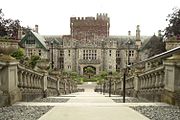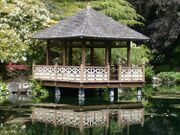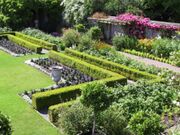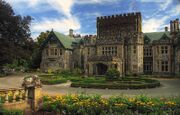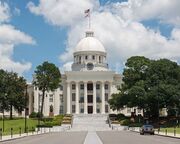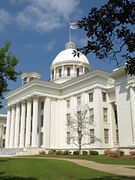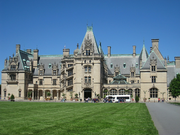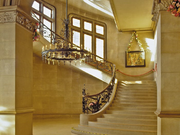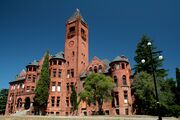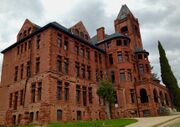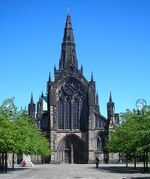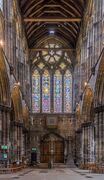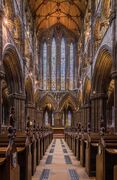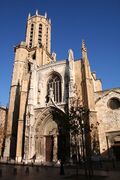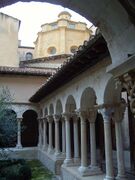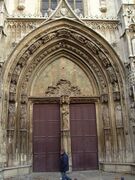List of Ebrarian National Landmarks
A National Landmark (Ebrarese: Puncto National de Referiment), or PNR, is a building, district, object, site, natural feature, or structure in Ebrary that is officially recognized by the Ministry of Environment and Tourism for its noteworthy historical, natural, scientific, or religious significance.
Adansema
Parco National Planas Benedicte
Parco National Planas Benedicte (Anglish: Blessed Plains National Park) is the largest national park and nature preserve in Ebraria, located in northern Adansema. The park comprises many square kilometers of temperate grasslands, and is home to some of the largest white-tailed deer herds in Argis. The park also contains a famous rare white deer herd, which has grown to almost 800 members in recent years.
Ceres
Castello Providence
Originally a folly commissioned by Ceres mayor Marco Sartor in 1904, Castello Providence is now the official residence of the Sovereign Protector. Castello Providence sits on a large estate of gardens and forest in the Ebrarian capital. The structure was built in the Gothic Revival style. After the Ebrarian Revolution, the government of Ebrary purchased the castle for official use and Sovereign Protector Daniel Lucas made it his full-time residence in 1987. It is sometimes referred to by its previous name, Castello Ceres.
Gardens at Castello Providence
Three gardens are part of the grounds of Castello Providence: the Rose Garden, the Occidental Garden, and the Oriental Garden. The gardens are maintained and have served as staging-grounds for diplomatic talks, press conferences, and social gatherings hosted by the Sovereign Protector. A team of full-time groundskeepers and gardeners are employed by the Ebrarian government to maintain the gardens and the rest of the grounds.
Palatio de Estalta
The Palatio de Estalta is the meeting place of the Ebrarian Parliament, located on Estalta Hill in Ceres. The building was constructed from 1867 to 1869 in the Laimiaic Revival style to house the Parliament of the Kingdom of Ebrary after the previous building burned down. Successive legislatures in Ebrary have met in the building.
Palatio Presidential
Constructed between 1935 to 1942 in the Châteauesque style, the Palatio Presidential is the official residence of the president of Ebrary. The building was never used by the presidents of the Republic of Ebrary, because of a coup in 1943 which reinstalled the monarchy. However, the royal family of Ebrary appropriated the home and significantly renovated it for use as a royal residence. During this time, it was referred to as the Palatio Nove Royal (New Royal Palace). After the Ebrarian Revolution, all royal buildings were confiscated by the new government, and the building was then selected by a Parliamentary committee and approved by vote of Parliament as the official residence of the president of Ebrary.
The Palatio Presidential's grand size has enabled it to also house the offices of the president and deputy president, their chief counselors and advisors, the president's press secretary and state press corps, and all support staff.
Castello Corporation
The Castello Corporation (Anglish: Guild Castle) is the home of the Supreme Court of Ebrary. The building was built in the Aromanesque revival style in 1885. The building served as an administrative building of the province of Laverna until the 1950s and then as a storage and office building for the government of the Kingdom of Ebrary. The building became the home of the Supreme Court in 1991 and was renovated in 2005.
Cathedral de Ceres
The Cathedral de Ceres is the seat of the Bishop of Ceres, head of the Ecclesiastical Amendant Church of Ebrary. It was built in the Gothic style in the 12th century. Iconoclasts destroyed much of the iconography after the Amendant Reformation. The cathedral houses the relics of St. Marcus Ebraius, and it was named the Cathedral de St. Ebraius until 1567 when it was renamed to its current name.
Church of the Pentecost
The Church of the Pentecost in Ceres is an Aroman Christian cathedral, the seat of the Bishop of Laverna, and the headquarters of the Orthodox Aroman Church in Ebrary. Restoration work was performed on the cathedral in the 19th century, and more renovations were undertaken upon its transfer in ownership to the Orthodox Aroman Church in Ebrary in 1939.
Urtedo Cathedral
Urtedo Cathedral, located in the city of Urtedo is the seat of the Archbishop of Urtedo, and the headquarters of the Ebrarian Orthodox Church. The cathedral is built on the site of a 6th-century Aroman-style church. Renovated and rebuilt from the 13th until the early 19th century, it includes Aroman columns and parts of the original 6th-century church, as well as Gothic, Neo-Gothic, and Aromanesque styles. Before the Amendant Reformation, the church housed a monastic community, but their organization was dissolved by the Church of Ebrary during the reign of King Gustav II. From there, the cathedral served various functions, but a mob of Amendant iconoclasts did great damage to the cathedral in 1585. Restoration work was performed on the cathedral in the centuries afterwards, including the restoration of a great many sculptures and icons. The cathedral was transferred to the Orthodox Church in 1940 after their separation from the Church of Ebrary.
Laverna
Caverna Petra
Caverna Petra is a prehistoric dolmen located in northern Laverna province. It is widely considered to be Ebrary's most iconic landmark dating from prehistoric times. The megalith dates from 3000 - 2500 BCE and was constructed from blocks of granite. The site was excavated in the early 20th century and found to contain beads, pottery, and human remains, and it is presumed the site was a tomb or burial place of some sort.
